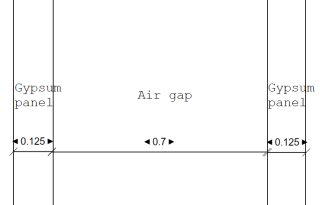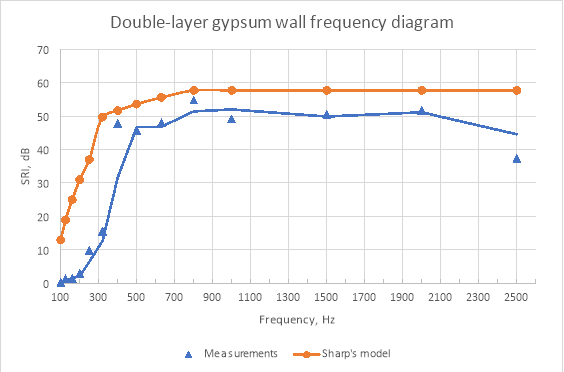This article observes the impact of air gaps within a double-layered wall consisting of 2 layers of gypsum panels of 12.5 mm thickness and a 70 mm air gap in the middle on the sound reduction index (SRI). Through experimentation carried out by following ISO 140, it was found that the observed wall has SRI value

Keywords: Air gap, sound reduction index, double gypsum wall, sound insulation, soundproofing properties.
1. Introduction
A human’s well-being can be directly linked to the acoustic comfort of their personal space at home. Disturbance of silence by extraneous loud noises can negatively affect a person’s mental health; it may disturb sleep and cause stress and hypertension [1]. That is why it is crucial for engineers to design and construct residential buildings with an acceptable level of wall sound insulation regulated by building codes. Barriers in air wave propagation reduce the energy of its transmission, and its efficiency can be represented numerically as the sound reduction index (SRI) [2]. In the middle of the 20 th century, new technologies were introduced into the construction field, which particularly influenced building codes and sound insulation requirements. Latest trends in reducing construction costs and due to investment interests, sound insulation requirements were lowered [3]. Due to the reduction of requirements, construction companies started to build houses with inefficient sound insulation of inter-apartment walls. This issue leads to a greater need for sound-insulating materials. Sound-insulating materials like mineral wool can be used by engineers to cope with the noise pollution problem. Such porous materials are effective in terms of soundproofing because of energy dissipation resulting from the material structure [4]. An alternative way to manage the problem is the use of double-layered walls without mineral wool, but air gap between the two layers. This approach can reduce construction costs and maintain sufficient noiseproofing.
2. Methods
2.1 SRI measurement
In Figure 1, the schematic layer composition of the double-gypsum wall partition is represented, consisting of 2 gypsum panels of 12.5 mm thickness each and a 70 mm air gap in between.
All measurements of the SRI of the observed wall structure were carried out complying with ISO 140–2. The size of the wall is 3 by 3 meters in height and width. Overall thickness is 95 cm.

Fig. 1: Schematic layers composition
2.2 Sharp’s model
In the laboratory report [5], Ben Sharp empirically derived function of transmission loss can be represented as a set of equations:



Where




3. Results

Fig. 2: Frequency graph of double-layer gypsum wall
Figure 2 shows plots of frequency graphs derived from both experimental results and Sharp’s empirical model. From this graph, it can be seen that Sharp’s model is following the trend line accurately, however, the experimental measurements trendline is not so accurate due to human and instrumental errors.
4. Discussion
The results represented in Figure 2 show the difference between approximate ideal conditions (Sharp’s model) and a real implementation of the double-layer wall. That is why, on average, real SRI is 7dB lower than the perfect one. The SRI, according to measurements, is 45.6 dB. The reason why there is a difference between Sharp’s model and experimentation may arise from several aspects, such as differences in experimental conditions, noise leak through adjacent walls, floor, and ceiling.
As the observed wall structure is placed inside a building, the building’s frame material and fulfillment material also impact the SRI of the double-leaf gypsum enclosing structure [6]. For example, in a building with concrete bearing walls of significant thickness, it is possible to achieve SRI

The abovementioned difference between the SRI model and real measurements could result from non-ideal experimental conditions, for example, noise leakage through holes, structural elements, rigid connection between the double-layer wall and bearing walls, and the ceiling. For example, if the installation does not include vibration isolation spacers between the gypsum plasterboard sheets and the floor/ceiling, there will inevitably be a reduction in the air noise reduction index due to the transmission of vibrations through the structural parts of the building.
In practice, even number of screws can decrease the sound reduction factor of structures with two gypsum panels [7]. Experiments show that affected frequencies are in range between 300 Hz and 4000 Hz, and measured SRI difference between scenarios achieve 11dB: 1) screws tightened well at seven rows per one sheet, 2) crews loosely fixed only on top and bottom of a sheet. Thus, in a real application, it is better to reduce the number of screws to minimize adverse effects.
5. Conclusion
The observed double-layered gypsum wall shows of sound reduction index of 45.6 dB, which is significantly lower than what this structure can achieve in more ideal laboratory conditions. The real implementaiton has different obstacles, which reduce soundproofing characteristics, such as the method of construction of the wall, the type of building, number of screws and ineffective vibro-isolation between the gypsum wall and its frame.
References:
- Effect of Noise Pollution on Human Health / Pantawane R. N., Kanchan V. Maske, Namrata S. Kawade // IARJSET. — 2017. — Т. 4, № 3. — С. 33–35.
- Noise and Vibration / G. F. Hundy, A. R. Trott, T. C. Welch // Refrigeration, Air Conditioning and Heat PumpsElsevier, 2016. — P. 449. https://doi.org/10.1016/B978–0-08–100647–4.00029–2
- Sound insulation of buildings / J. Holger. — Istanbul, Turkey: 2024. — С. 2.
- The Effect of Air Gap Thickness on Sound Absorption Coefficient of Polyurethane Foam / M. Mohd Moesli, N. A. Sa’at, N. Hasril, I. Mahdi Che, N. Y. Nik Hassanuddin, D. Y. Mohd Subhi — 2012. — Т. 5, № 2. — С. 176–187.
- Prediction Methods for the Sound Transmission of Building Elements / B. Sharp // Noise Control Engineering. — 1978. — Т. 11. — С. 71. https://doi.org/10.3397/1.2832099
- Sound insulation of buildings / J. Holger. — Istanbul, Turkey: 2024. — С. 9.
- Influence of panel fastening on the acoustic performance of light-weight building elements: Study by sound transmission and laser scanning vibrometry / N. Bernardus, H. Muellner, L. Ludovic, R. Monika, G. Christ — Т. 346, № 2015. — С. 100–116.

